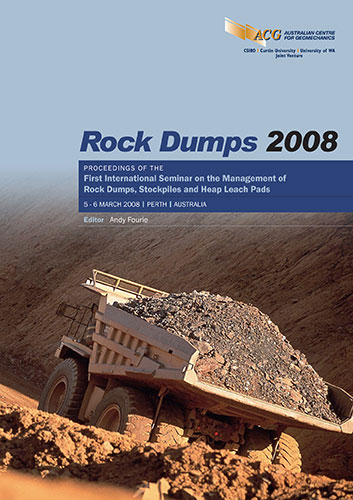The Analysis of the Pore Evolution of Ore Granular Media During Bacteria Heap Leaching Based on X-Ray Computerised Tomography

|
Authors: Wu, AX; Yang, BH; Yin, SH; Wang, YM |
DOI https://doi.org/10.36487/ACG_repo/802_19
Cite As:
Wu, AX, Yang, BH, Yin, SH & Wang, YM 2008, 'The Analysis of the Pore Evolution of Ore Granular Media During Bacteria Heap Leaching Based on X-Ray Computerised Tomography', in AB Fourie (ed.), Rock Dumps 2008: Proceedings of the First International Seminar on the Management of Rock Dumps, Stockpiles and Heap Leach Pads, Australian Centre for Geomechanics, Perth, pp. 219-229, https://doi.org/10.36487/ACG_repo/802_19
Abstract:
The bacteria column leaching experiment of low grade sulphide ore was conducted and the ore granular media were scanned by X-ray computerised tomography scanner before and after leaching. Based on the image processing operation, the spatial distribution of the porosity, and the change of pore size distribution and connectivity before and after leaching were investigated. In addition, the mechanism of pore evolution during leaching was also analysed. The results indicate that the porosity, pore size and pore connectivity of the ore granular media during leaching all have spatial and temporal variability. After leaching, the porosity distribution along the column became more inhomogeneous and assumes a decreasing trend from top to bottom, especially the bottom zone, with porosity decreasing greatly. The amount of larger pores increased at the top and middle zones after leaching while decreased at bottom zone. The connectivity of the top and middle zone was improved but deteriorated at the bottom zone. The main mechanisms for pore evolution are the subsidence of the entire granular ore body and the transportation and accumulation of the fine particles, chemical precipitates and colloidal substance at local areas.
References:
Al-Raoush, R.I. and Willson, C.S. (2005) Extraction of physically realistic pore network properties from three-
dimensional synchrotron X-ray microtomography images of unconsolidated porous media systems. Journal of
Hydrology 300 (5), pp. 44-64.
Benamar, A., Ahfir, N.D., Wang, H.Q. and Alem, A. (2007) Particle transport in a saturated porous medium: Pore
structure effects. C. R. Geoscience 339, pp. 674-681.
Hirono, T., Takahashi, M. and Nakashima, S. (2003) In situ visualization of fluid flow image within deformed rock by
X-ray CT. Engineering Geology 70(7), pp. 37-46.
Kamath, J., Xu, B., Lee, S.H. and Yortsos, Y.C. (1998) Use of pore network models to interpret laboratory experiments
on vugular rocks. Journal of Petroleum Science and Engineering 20(6), pp. 109-115.
Ketcham, R.A. and Carlson, W.D. (2001) Acquisition, optimization and interpretation of X-ray computed tomographic
imagery: applications to the geosciences. Computers and Geosciences 27 (3), pp. 381-400.
Lin, C.L., Miller, J.D. and Garcia, C. (2005) Saturated flow characteristics in column leaching as described by LB
simulation. Minerals Engineering 18(3), pp. 1045-1051.
Liu, J.S., Polak, A., Elsworth, D. and Grader, A. (2005) Dissolution-induced preferential flow in a limestone fracture.
Journal of Contaminant Hydrology 78(3), pp. 53-70.
Mecke, K. and Arns, C.H. (2005) Fluids in porous media: a morphometric approach. Journal of Physics: Condensed
Matter 17(2), pp. 503-534.
Nakashima, Y., Nakano, T., Nakamura, K., Uesugi, K., Tsuchiyama, A. and Ikeda, S. (2004) Three-dimensional
diffusion of non-sorbing species in porous sandstone: computer simulation based on X-ray microtomography
using synchrotron radiation. Journal of Contaminant Hydrology 74(3), pp. 253- 264.
Pierret, A., Capowiez, Y., Belzunces, L. and Moran, C.J. (2002) 3D reconstruction and quantification of macropores
using X-ray computed tomography and image analysis. Geoderma 106(6), pp. 247-271.
Wildenschild, D., Hopmans, J.W., Vaz, C.M.P., Rivers, M.L., Rikard, D. and Christensen, B.S.B. (2002) Using X-ray
computed tomography in hydrology: systems, resolutions, and limitations. Journal of Hydrology Vol. 267 (9),
pp. 285-297.
Wu, A.X., Yang, B.H. and Xi, Y. (2007) Pore structure of ore granular media by computerized tomography image
processing. Journal of Central South University of Technology 14(2), pp. 220-224.
Hydrology of Rock Dumps
Rock Dumps 2008, Perth, Australia 229
© Copyright 2025, Australian Centre for Geomechanics (ACG), The University of Western Australia. All rights reserved.
View copyright/legal information
Please direct any queries or error reports to repository-acg@uwa.edu.au
View copyright/legal information
Please direct any queries or error reports to repository-acg@uwa.edu.au